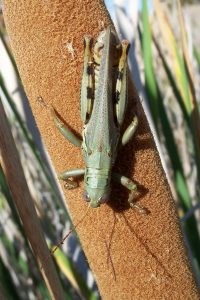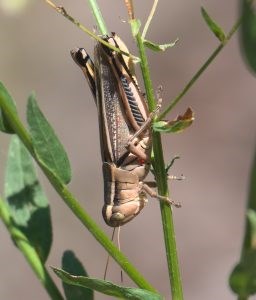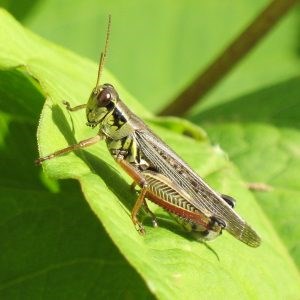This content was originally published by the Longmont Observer and is licensed under a Creative Commons license.
I’ve been seeing lots of little grasshoppers around my yard and it got me to wondering about how many kinds of grasshoppers inhabit Colorado. So I did some digging and it turns out there are over 100 species of grasshoppers in Colorado! Among the ones I’ve seen in my yard are the two-striped grasshopper and the differential grasshopper. Each species of grasshopper has differences in their biology, habitats, and eating habits. However, there are some generalizations that can be made about their biology.
Grasshoppers lay eggs in the soil in a tight bundle called pods, usually in late summer and fall. The pods are surrounded by a type of froth that helps protect the eggs, but the amount of froth depends on each species. Egg pods may contain up to 40 eggs, with each female producing up to 25 pods each.
Grasshoppers prefer to lay their eggs in soil that is dry and undisturbed. When a good patch of soil is found, several grasshoppers may lay their eggs there, leading to the formation of egg beds. For most species of grasshoppers, the eggs will winter in the soil. The embryos will develop in the eggs until the weather becomes unfavorable, and then development pauses. By the time this occurs, the embryo will be 80-90% developed. To prevent the egg from hatching too early, resumed development requires that there be a long period of cold before a warming spell. The length of time it takes for an embryo to completely develop after the pause is dependent on the soil temperature.
Eggs will hatch mid- to late spring. The warmer the soil temperature, the earlier the eggs will hatch. The hatching of eggs is not necessarily synchronous, because eggs may be laid in areas that have different exposure to the sun. Therefore, some sites may become warm more quickly than others and will therefore hatch first. Some species of grasshoppers don’t spend the winter in the egg, but in the nymph stage instead.

After the eggs hatch, the resultant nymphs will undergo a series of molts as they mature. Typically, the number of molts a grasshopper nymph undergoes is between five and six, but the exact number depends on the species. Sometimes females will undergo one more molt than the males. The molt that occurs immediately after hatching is not included in the total number of molts the nymph undergoes.
The process of molting itself takes less than 30 minutes to complete. How quickly nymphs develop depends on temperature and the quality of available food. Generally, it takes between 30 and 50 days for a nymph to develop into an adult. During development into adulthood, nymphs will increase the number of segments their antennae have, and their wings will grow larger.
Depending on the species, males and females may appear very different. Most adults don’t survive the winter. Adults that developed late will survive until the first frost whereas adults that developed early will die in mid-summer.
Courtship behavior in grasshoppers can be complex, including olfactory, acoustic, and tactile signals. Males usually produce signals that attract females. Males may flash their wings which are brightly colored and produce whirring or snapping noises. In some species, the male approaches the female stealthily and pounces on her.

All grasshoppers will move if they run out of food at their current location. But some species form swarms. These are dreaded by farmers because they can quickly decimate crops. Such swarms are usually formed during hot, dry weather. The density of grasshoppers is usually one to five grasshoppers per square yard. However, in a swarm, density can be up to a 100 grasshoppers per square yard. It still is not known exactly what causes these swarms to occur.
What food is eaten depends on the species. Some grasshoppers depend on specific plants to survive whereas others are more generalist feeders. Grasshoppers also feed on plant debris and insect material, and cannibalism frequently occurs. The food preferences of each species is correlated with the kind of mouth the grasshopper has. Those species that feed on grass have relatively blunted teeth on their mandible. Those that feed on forbs (herbaceous flowering plants) have sharper teeth. Grasshoppers use visual and olfactory cues to help recognize their preferred host plants. Chemical differences in the plant, such as the amount of sugars and phospholipids, influence plant choice as well.

Grasshoppers can be hard to control because they are so mobile. Weather is probably the most influential natural control on grasshopper populations. Blister beetles feed on grasshopper egg pods. Adult robber flies prey on grasshoppers, and other species of flies can become internal parasites for grasshoppers. In addition, birds and coyotes prey on them. Grasshoppers are also prone to a fungus that kills them as they cling to a plant. You may find dead grasshoppers still clinging to a grass stalk when they have been infected by this fungus. During wet weather, a nematode may infect grasshoppers. Chemical control of grasshoppers typically involves the use of sprays or bait directed at either the eggs or very young grasshoppers. Using these chemicals when grasshoppers are more developed will not meet with good results as adults are highly mobile.
The next time you are out and about in your garden, keep a look out for grasshoppers. There are several websites you can use to help identify which species you have, such as this one and the Project Noah website. You may just be surprised at how many different kinds of grasshoppers your have in your yard!


